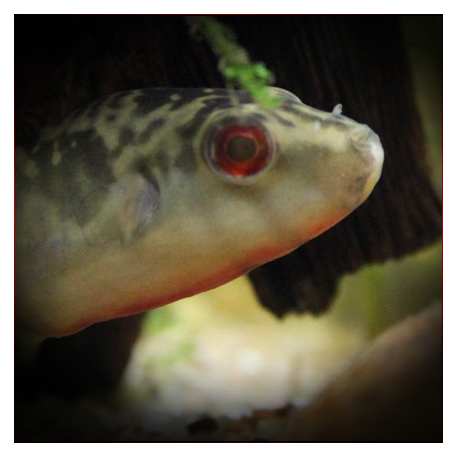More info
Datasheet
| Minimum Tank Size | 60 litres / 15.85 US gallons |
| Maximum Size | 5.0cm / 1.97inches |
| Temperature | 20°C / 68.00°F - 28°C / 82.40°F |
| Hardness | 1.01dgH / 18ppm - 12.05dgH / 215ppm |
| pH | 5.0-7.5 |
General Description
C. salivator, commonly known as the 'striped redeye puffer' or 'zebra puffer,' is part of a group called 'red-eyed puffers,' with distinct features differentiating it from other members. Belonging to the family Tetraodontidae, it boasts unique morphological adaptations, such as the ability to inflate its body when stressed. These secondary freshwater fishes are known for their toxic flesh due to toxins like tetrodotoxin or saxitoxin produced by bacteria or acquired through the food chain.
Aquarium Setup
To create an ideal habitat for C. salivator, a well-decorated aquarium with driftwood roots, branches, and abundant aquatic plants is necessary. Floating plants can offer shade, while dried leaf litter aids in establishing microbe colonies crucial for fry development. Maintaining water quality is crucial as the species is sensitive to deteriorating conditions. Adequate water movement and regular small changes are recommended to mimic their natural habitat.
Behaviour
Although C. salivator is less aggressive than other members of its genus, it thrives best when kept alone or with peaceful, schooling cyprinids of appropriate size to avoid competition or threat. While loosely gregarious, males tend to be territorial, necessitating sufficient cover and space in group setups. The fish can exhibit territorial behavior but can coexist if provided with ample hiding spots.
Feeding and Diet
With no true teeth, C. salivator's jawbone is modified into four fused toothlike structures that grow continuously. Their diet typically consists of shelled invertebrates like snails, small crab legs, and cockles. Aufwuchs and food like chopped shellfish, earthworms, and chironomid larvae are also recommended. While dried products should not dominate their diet, pelleted formats with a tough consistency can be beneficial.
Reproduction & Dimorphism
Specifics of C. salivator's reproduction are unrecorded, but observations in closely related species indicate scattering eggs among vegetation, with males guarding the brood during incubation. Adult males exhibit distinct features like well-developed dorsal and ventral keels, specially during threat displays and courtship. Sexual dimorphism is evident in coloration, with males displaying red ventral surfaces with crossbars while females showcase cream-colored bodies with dark stripes.
Habitat and Distribution
This species, primarily found in the Malaysian state of Sarawak, Borneo, shows a preference for flowing water. Their habitats include streams with clayey, steep margins, and substrates of soft silt, sand, and leaf litter. They inhabit areas with submerged logs and roots, and in some cases, rocky, riffle-like stretches. Sympatric fish species found in their habitat include Rasbora cephalotaenia, Homalopteroides nebulosus, and others.

